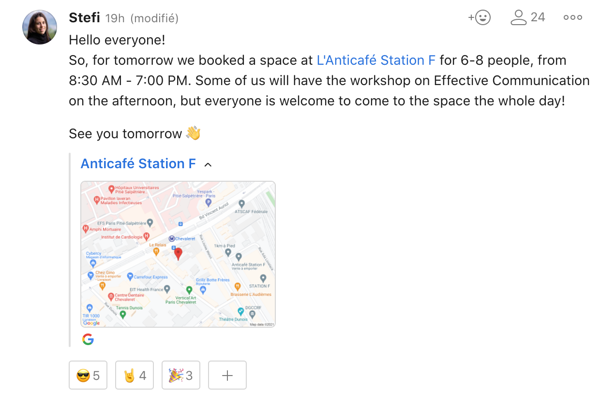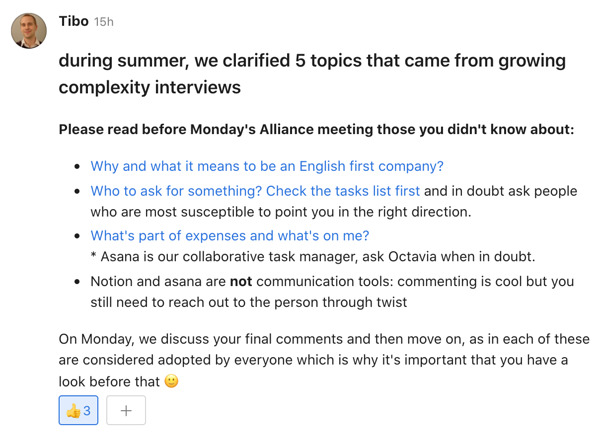September 28, 2021
Remote working: why did we give up our offices and what do we do now?
Ferpection has recently gone full remote. While this is not a major change, as remote work was already integrated into our operations long before COVID, this change has led us to ask ourselves some questions (some of which were already on our minds before):
First, why did we opt for remote work?
Since its inception in 2014, Ferpection has chosen to promote telework in the belief that it:
- Favors recruitment, especially on certain saturated positions in the greater Paris region, or even in the whole of France. Working remotely logically allows us to cross borders and thus attract diverse talents. For example, we have Gerardo in Belo Horizonte, Brazil, Marie in Creuse and Charlotte in Lisbon.
- Allows us to support everyone's projects. A move is no longer a reason to resign, and many of us have left Paris since joining Ferpection. A life experience abroad is no longer a reason for resignation either. Grégoire chose to learn Portuguese with a few months in Brazil, while Théo opted for Toronto to perfect his English. We also have many dual nationalities – for example, our organization allows Katie to visit her family in the US regularly while working from New York. Clearly, we have no shortage of examples!
- Helps productivity by preserving everyone's attention span. At Ferpection, it was already agreed that the office was not a work space. We went there when we needed to see people, talk, but not really to work. For this reason, we are convinced that each person should be free to choose their work environment according to their priorities: at home, from a co-working space or a café, everyone can make their own choices.
What are the specific challenges of the full remote model?
To be honest, we do not have all the answers yet! First of all, because we learn over time, according to the evolution of the company and above all the personalities that compose it. However, we have managed to identify a few key elements. On each subject, we will share with you what works (at least for us!) and what we are still wondering about.
Creating and maintaining team cohesion.
At the risk of starting with a contradiction, in order to work remotely, you also need to see each other! Thus, we have chosen to reallocate the budget initially dedicated to the renting of our offices in moments of sharing “in real life”:
-
Twice a year the whole team goes on “Company Retreats”: diving in Malta, skiing in the Alps or relaxing in the South of France, there is never a dull moment!
-
We also meet three times a year for “Office days” – privileged moments for group work.
-
We also encourage individual initiatives by giving everyone the freedom to organize spontaneous meetings: a day in a coworking space, lunch on the terrace or happy hour are covered by expense accounts.
-
What's next? As you will have understood, we have not yet found the key to create convivial moments at a distance. We have set up “random buddies” (a time to share a coffee, via Zoom, and discuss), game nights... But these initiatives are punctual, and rarely renewed, a sign that it does not completely meet the expectations. Also, I invite you to read or reread our 8 tips to foster cohesion in remote teams
Leading a meeting
This may seem anecdotal, but it is key because meetings are (or should be) precious times of exchange.
-
With us, it starts with a rigorous preparation: sharing the agenda, outlining the time allocated to each subject. Pre-reads are also sent before the meeting.
-
Then, the moderator is not always the same person; it works on a voluntary basis. They are responsible for the agenda, promote mediation and summarize key messages.
-
It is also essential not to forget anyone! Especially if one part of the group is on site and the rest are online. Each person connects to their own screen and the camera is on for everyone!
-
Finally, meeting minutes are systematically taken and the actions to be taken during the meeting are directly integrated into our Asana task manager tool.
-
What's next? We are currently working on how to encourage active listening in meetings and are experimenting with new facilitation methods: starting with a meditation session, using a talking stick, encouraging inclusiveness... An article will soon be published specifically on this topic!
Communicate effectively
And make sure the information is accessible. In my opinion, this is the most complicated point because it requires a thorough rethinking of how information is processed and accessed.
- To begin with, it is essential to choose the right tools! We chose Twist to communicate and Asana to assign tasks. Phones are reserved for emergencies.
- We are also careful not to pollute or dilute messages. To do this, we force ourselves to ban internal emails to avoid never-ending chains and unnecessary CCs. We also encourage deactivating notifications in order to preserve individual concentration time. This way, a message is worked on before it is shared. This undoubtedly requires more time from the sender but allows a much better perception by the receivers.
- Finally, we document and “process” a lot. Allowing freedom in the workplace implies the ability to work asynchronously, not to mention because of the different time zones. Information must therefore be available and properly classified so that it can be found without having to ask for it.
- What's next? I have talked a lot about tools and processes, but communication remains above all human. We therefore also aim to train the team in effective and benevolent communication methods: knowing how to give feedback, adapting your message to the person you are talking to, using non-violent communication, the possibilities are numerous!
Remote working also means managing from a distance!
- Managing from a distance starts with knowing how to let go, and above all eliminating anything that could be interpreted as surveillance. With Twist, for example, we have chosen a tool that does not indicate whether or not we are online. Turning off notifications and avoiding internal emails also limits the feeling of having to respond within a minute to any solicitation to justify that we are indeed behind our screen.
- We have also defined and adopted common “behaviors”. These are lines of conduct that promote teamwork and that we are committed to adopting. “Stick to why”, “Be curious, seek improvement”, “Always ask, always share”... It is up to you to define your own!
- We also consider that remote working has a cost. We start by providing the necessary equipment (screen, accessories, supplies) and we pay €2,500 per year to compensate for electricity, internet, heating, coffee...
- What's next? The list goes on and on! However, the difficulty with which we have struggled the most at a distance lies in everything that has to do with training and accompanying progress. This is not directly related to teleworking, but rather to the autonomy it brings. It is much more difficult for each individual to take a step back and identify their next steps without getting daily, direct feedback from a team. We have recently implemented a self-assessment grid, which also allows us to collect feedback from peers, as part of our salary self-determination. If you want to know more about it, take a look at our article on this subject.
As we said in the introduction, we do not have all the solutions yet. But we hope to have been able to bring out some ideas. However, if there are any burning questions, please feel free to share them with us. Also, if you have any answers to our remaining questions, we would love to hear from you! In the meantime, come and learn more about the team and our history.
All articles from the category: | RSS




